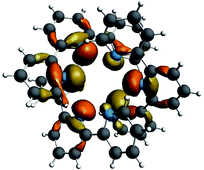DFT modeling of the relative affinity of nitrogenligands for trivalent f elements: an energetic point of view†
Abstract
In many theoretical studies dealing with the selective complexation of trivalent actinides with respect to trivalent lanthanides, the method of calculation is assessed by comparing computed geometries with crystal structures that are often available. Yet, the selectivity is better rationalized through thermodynamic data, as enthalpy and entropy terms. In this article, we have theoretically modeled competing complexation reactions of [Ce(terpy)3]3+, [U(terpy)3]3+, [Ce(MeBTP)3]3+ and [U(MeBTP)3]3+ systems (


 Please wait while we load your content...
Please wait while we load your content...